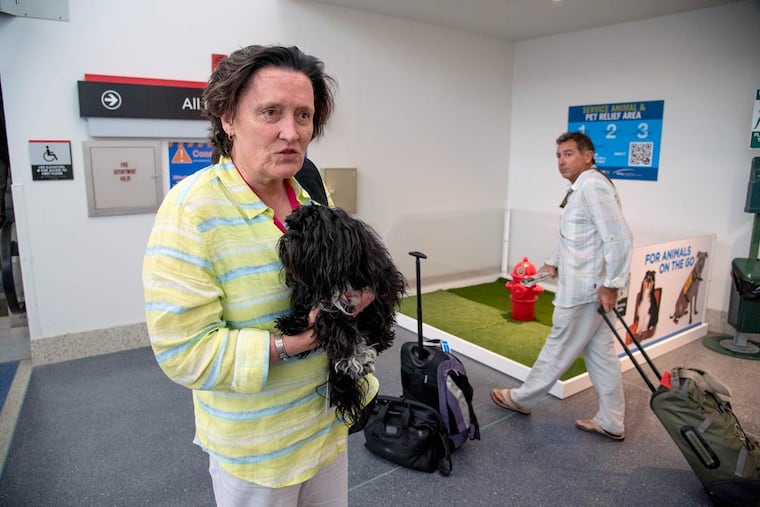For service pets inside PHL, relief is here
The term "dog days of summer" has new meaning at Philadelphia International and other U.S. airports. A new federal rule, as of last Thursday, requires U.S. airports receiving federal financial aid to provide pet potties inside airport terminals, in areas past security.

The term "dog days of summer" has new meaning at Philadelphia International and other U.S. airports.
A new federal rule, as of last Thursday, requires U.S. airports receiving federal financial aid to provide pet potties inside airport terminals, in areas past security.
The law, titled Nondiscrimination on the Basis of Disability in Air Travel, mandates that airports with 10,000 or more annual passengers provide indoor wheelchair-accessible pet-relief areas convenient to airline gates for service animals that accompany passengers departing, connecting, or arriving on flights.
Philadelphia International, which serves 86,000 passengers a day, has installed seven pet-relief areas in Terminals A-East and A-West, B, C, D, E, and F.
The 7-foot by 8-foot spaces feature decorative dog decals, a faux fire hydrant, artificial grass, and waste bags for cleanup. Travelers can soon learn the locations on the airport website phl.org and at customer information counters.
"It's really great," said Jessica Spencer, a trainer for Canine Partners for Life in Cochranville, showing Gwen, a black Labrador retriever service dog, the relief area in Terminal E.
"A lot of our clients have fatigue issues, pain issues, so on a layover to have to go outside, find an area, then get back through security to their gate, it's inconvenient and stressful."
Sophie, a poodle and shih-tzu service dog, was at PHL en route from Staunton, Va., to New York when owner and trainer Jennet Ingis spotted one of the new relief areas.
"It's the first time I've seen this," said Ingis, who wondered aloud whether dogs accustomed to fresh air and dirt would want to go on fake grass.
"It might work; I don't know," she said. "It's an interesting question."
Pet-relief areas have been located outside airport terminals for years. Philadelphia airport has seven "pet ports" along the departures road and the arrivals road near the baggage claims.
But with tighter airport security, and longer lines getting through Transportation Security Administration screening, the Department of Transportation wanted pet-relief areas inside terminals so that travelers who have gone through security once would not have to do so a second time just to take a service animal for relief.
The indoor areas can also benefit passengers flying with small pets - generally dogs less than 20 pounds - that can be taken in cabins on planes, and handlers of TSA bomb dogs that work at airports.
The cost of PHL's new pet restrooms - $6,000 each - will be paid by the airlines through their rates and charges, and not tax dollars, said airport spokeswoman Mary Flannery.
Nationwide, about 849 airport terminals will have indoor service animal relief areas.
The Transportation Department has estimated that the overall cost will be about $88.1 million over 20 years, which includes the cost of construction and maintenance of the areas, as well as the amount of rent that airports will forgo by using space in terminals that might have been rented to restaurants and other retail vendors.
Liberty Resources Inc., a Philadelphia-based consumer group that advocates for people with disabilities, met with the airport planning team and thinks the indoor relief areas are "a great idea," said manager Bianca Barnes.
Jill Gross, of Roxborough, is a guide-dog user and frequent traveler. Two years ago, on a trip to Las Vegas for a conference, her Philadelphia departing flight was delayed and she missed a connecting flight in Chicago. When she landed at Chicago O'Hare airport around midnight, she was stuck in the airport until the next morning.
Gross said she could not take her German shepherd outside for relief, because the airport doors were locked - and she would not have been able to get back in. "I had nowhere to walk my dog."
"I have had numerous incidents where you are making a long trip, and you have a connecting flight, and you may not have time to go outside," said Gross, who teaches literacy to adults with disabilities.
The federal government said the number of service animals has grown dramatically in recent years: about 31,000 service dogs in the United States and 53,000 worldwide.
Two-thirds are guides for the blind, and one-third perform other tasks. An estimated 8 percent are therapy animals or social companions for people with psychological disabilities, the Transportation Department said.
215-854-2831
@LoydLinda